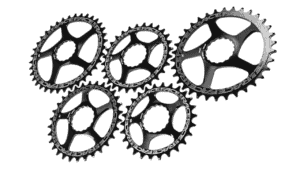We know BMX bikes to be many things. By definition, they’re bikes with short pedal reach, low seats, and durable crankset.
Put them to rough use and they’ll stand up to whatever abuse you throw at them.
And as you put them to different riding styles, they’ll use a few moving parts to meet your expectation on performance. But,
Do BMX Bikes Have Gears?

BMX bikes have gears. The older models have gear ratio of 44/16, and newer improved models have smaller gear ratios such as 22/8, 28/10, 33/12, and 36/13. Small gearing not only makes cycling easy but also tends to make grinding clear.
BMX bikes are quite improved these days, with almost all new models featuring small gears. Still, it’s possible to find older models that have bigger gears.
BMX bikes gearing feature depends on four things: gain ratio, gear inches, rollouts, and sprockets.
There are at least 11 gearing ratio for BMX bikes.
These are 22/8, 23/8, 25/9, 27/9, 28/9, 30/9, 28/10, 30/11, 33/12, 36/13, and 36/16.
While a BMX bike can come with any of these gears, the 27/9 and 28/9 ratios are quite common and tend to be the preference among BMX rider.
The different gear ratios give you the freedom to choose what’s best for you.
And from a performance standpoint, they do make the bike easier to pedal right from a complete stop.
I should caution you:
The gear ratio is perfect only for short bursts of speed, so you aren’t going to enjoy a long, sustained speed.
I haven’t come across a BMX bike that comes with multiple gears.
Which brings me to a very bold conclusion that with bicycle motocross, multiple gears are rare if any.
How Many Gears Do BMX Bikes Have?
Unlike road bikes and expensive mountain bikes, BMX bikes have a single gear configuration.
Whenever bicycle motocross fans talk about gears on a BMX bike, the two common terms they tend to use interchangeably are chainring and sprocket.
Just so we’re on the same page:

A chainring refers to the round, spiky bit attached to the cranks of a BMX bike.
It pulls the chain around as you pedal, transfers the force to the sprocket, which responds by pushing the bike forward.
We can define a sprocket as the rear driver fixed to the hub of a BMX bikes.
It rotates and pushes the rear wheel forward based on the force applied on the chain by the chainring.
I hope that isn’t confusing.
How Do Gears Work on a BMX Bike?
Now get this:
Even if multiple gears are a rarity in BMX bikes, you still have to consider the number of teeth on the sprocket and the chainring as well as the gear ratio.
But exactly how do you calculate the gear ratio?
Well, it’s simple:
- Calculate the number of teeth on the chainring and the sprocket
- Divide the number of teeth of the chainring by the number of teeth of the sprocket
The result is your BMX bike’s gear ratio.
But what does that even mean anyways?

It means that the rear wheel will rollover approximately the number of times the number of the gear ratio with every complete rotation of the chainring.
The higher the gear ratio, the harder it is to pedal. BMX bikes with lower gear ratio, on the other hand, are quite easy to pedal.
There’s a reason why the typical gear ratio for many modern BMX bikes sits at 25/9.
If we do the math, we get a gear ratio of 2.77, which is much better than if the number of teeth is 33/12, 36/13, or 36/16.
Such a lower gear ratio means you can accelerate the BM bike with the least effort, enabling you to ride quickly into a trick such as J Hop, 360 degrees, and no handers.
If you’re someone who plans to use a BMX bike for racing, you have to give the generation of explosive power a deep thought.
For what it’s worth, the size of the chainring will definitely be different, usually much larger than the usual standard.
Are BMX Bikes Fixed Gears?
No, BMX bikes aren’t fixed gears.
Most, if not all, use hubs that enable you to freewheel or coast.
If you’ve been lucky to attend a BMX racing event, and you saw riders rolling forward without pedaling when going up and down ramps or turning, that should be a clear sign the hubs of their bikes are coasting.
It makes sense to state that you would have to place a special order if you want a fully fixed gear BMX bike.
Can You Put Gears on a BMX Bike?
You can put gears on a BMX bike provided you use an adaptor, as BMX bikes don’t have derailleur in the frame.
You can also accomplish this by investing in internally geared hub.
Keep in mind that while an internally geared hub is an option that allows you to benefit from the dropout in BMX frames, it tends to be quite expensive.
You also have to put the weight factor into consideration if you’re considering geared hubs.
Also Read:
Final Words
As you can see, BMX bikes do have gears, but the gear ratio to consider vary from bike to bike as well as based on what you tend to use the bike for.
Note that there will always be differences in wheel size and tire width, which also do contribute to the performance of a BMX bike.
So at times the conversation may span beyond just the gear ratio.
My advice when it comes to determining an appropriate gear ratio for you is you should at least consider your bmxing abilities first.
You should also look at the demand of racetracks and consider what would match your cycling rhythm.